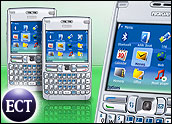
Research In Motion has lowered its Q3 forecast in response to the weakening U.S. economy. The company, which produces the iconic BlackBerry handsets, now expects adjusted earnings per share to fall between 81 US cents and 83 cents for the quarter. Its initial forecast called for earnings per share to range from 89 cents to 97 cents.
Third-quarter revenue is now expected to register between $2.75 billion and $2.78 billion, down from earlier forecasts of $2.95 billion to $3.10 billion.
RIM also signed up fewer new customers than expected, based on its predictions earlier this year. According to the company’s latest guidance, the number of net new BlackBerry subscriber accounts added in the quarter will be about 2.6 million rather than the 2.9 million forecast.
RIM will report its Q3 results on Dec. 18.
Conspiring Events
Canada-based RIM cited the unfavorable impact of the strengthening U.S. dollar as another reason for its revised downward projection for the quarter, which ended Nov. 29.
The confluence of a stronger U.S. dollar and a weaker economy threw off the momentum of two products launched in the quarter, it said. RIM had hoped that the release of the Storm and the Bold would expand its footprint into the consumer smartphone market now dominated by Apple’s iPhone.
The Storm and the Bold
The BlackBerry Storm — RIM’s answer to the iPhone — went on sale the Friday before Thanksgiving through Verizon Wireless. The Storm runs on Verizon’s 3G data network. It sports a touchscreen and a beautiful display, and it supports Microsoft Word, Excel and PowerPoint documents. With a two-year contract, the Storm is priced at US$199 after a $50 rebate.
Following an unexplained delay of several months, the Blackberry Bold found its way onto store shelves at the beginning of November. Its features include international 3G wireless capabilities, built-in GPS and WiFi. It is exclusively available through AT&T.
Both devices are sexier than RIM’s typical product line, which largely targets enterprise users, said Greg Sterling, principal of Sterling Market Intelligence.
The rationale behind the two phones’ development was obvious: “With weakness in enterprise spending, it makes sense for RIM to diversity into the consumer space,” he told the E-Commerce Times.
The Storm received mixed reviews, Sterling acknowledged, but the industry won’t know how well — or poorly — the two phones have performed until Q4 2008 or Q1 2009.
The Economic Factor
Clearly, though, the economy is the main drag on RIM sales. Consumers are cutting back on nonessential spending, and even smartphones priced in the $200 range fall in that category.
“The downturn is definitely hitting the smartphone segment of the electronics sector,” Ryan Reith, an analyst with IDC, told the E-Commerce Times.
IDC is in the process of revising its forecast for the smartphone market, but Reith did say that the firm believes there will be growth in the space despite lowered projections.
“The high-end segment is seeing some dynamic changes right now — $199 price point is a benchmark price for smartphones,” Reith noted. “Vendors that want to stay competitive have to met that price point.”
RIM made missteps with both rollouts, Reith observed. The delayed launch of the Bold “definitely hurt them.” Also, its $299 price point — higher than the iPhone — is having a negative impact on sales.
There are also software issues with the Storm, he said, but “that is not so bad, because software glitches are always easier to fix than when something is wrong with the hardware.”
RIM’s lowered projections are not surprising, commented Reith, as almost all of the vendors in the smartphone space have issued some sort of statement dampening earning expectations due to the struggling economy.























































Social Media
See all Social Media